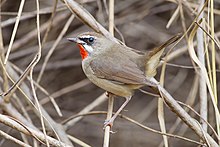| Siberian rubythroat | |
|---|---|

| |
| Male | |

| |
| Female | |
| Conservation status | |
 Least Concern (IUCN 3.1) | |
| Scientific classification | |
| Domain: | Eukaryota |
| Kingdom: | Animalia |
| Phylum: | Chordata |
| Class: | Aves |
| Order: | Passeriformes |
| Family: | Muscicapidae |
| Genus: | Calliope |
| Species: | C. calliope |
| Binomial name | |
| Calliope calliope (Pallas, 1776) | |

| |
Summer Winter | |
| Synonyms | |
|
Luscinia calliope | |
The Siberian rubythroat (Calliope calliope) is a small passerine bird first described by Peter Simon Pallas in 1776. It was formerly classed as a member of the thrush family, Turdidae, but is now more generally considered to be an Old World flycatcher of the family Muscicapidae. The Siberian rubythroat and similar small European species are often called chats.
It is a migratory insectivorous species breeding in mixed coniferous forests with undergrowth in Siberia. It nests near the ground. It winters in Thailand, India, Indonesia and Bangladesh (See wintering range map). It is an extremely rare vagrant to Western Europe, having occurred on a very few occasions as far west as Britain. It is also an extremely rare vagrant to the Aleutian Islands, most notably on Attu Island.
This species is slightly larger than the European robin. It is plain brown above except for the distinctive black tail with red side patches. It has a strong white supercilium. The male has a red throat edged with a narrow black and then a broad white border. Females lack the brightly coloured throat and borders. The male has a song similar to a harder version of the garden warbler.
The Siberian rubythroat was previously placed in the genus Luscinia. A large molecular phylogenetic study published in 2010 found that Luscinia was not monophyletic. The genus was therefore split and several species including the Siberian rubythroat as the type species were moved to the reinstated genus Calliope. Calliope, from classical Greek meaning "beautiful-voiced", was one of the muses in Greek mythology and presided over eloquence and heroic poetry.
Gallery
Notes
- BirdLife International (2016). "Calliope calliope". IUCN Red List of Threatened Species. 2016: e.T22709701A87886433. doi:10.2305/IUCN.UK.2016-3.RLTS.T22709701A87886433.en. Retrieved 19 November 2021.
- Urs N. Glutz von Blotzheim; K. M. Bauer (1988). Handbuch der Vögel Mitteleuropas. ISBN 3-923527-00-4.
- Lekagul, Boonsong; Round, Philip D.; Wongkalisn, Mongkol; Komolphalin, Kamol; King, Ben. A Guide to the Birds of Thailand.
- "The British List". British Ornithologists' Union. Retrieved 24 September 2010.
- Sangster, G.; Alström, P.; Forsmark, E.; Olsson, U. (2010). "Multi-locus phylogenetic analysis of Old World chats and flycatchers reveals extensive paraphyly at family, subfamily and genus level (Aves: Muscicapidae)". Molecular Phylogenetics and Evolution. 57 (1): 380–392. doi:10.1016/j.ympev.2010.07.008. PMID 20656044.
- Gill, Frank; Donsker, David, eds. (2016). "Chats, Old World flycatchers". World Bird List Version 6.2. International Ornithologists' Union. Retrieved 20 May 2016.
- Jobling, James A. (2010). The Helm Dictionary of Scientific Bird Names. London, United Kingdom: Christopher Helm. p. 85. ISBN 978-1-4081-2501-4.
External links
 Media related to Calliope calliope at Wikimedia Commons
Media related to Calliope calliope at Wikimedia Commons Data related to Calliope calliope at Wikispecies
Data related to Calliope calliope at Wikispecies- Calliope calliope in Field Guide: Birds of the World on Flickr
- "Calliope calliope". Avibase.

| Taxon identifiers | |
|---|---|
| Calliope calliope |
|
| Motacilla calliope | |

